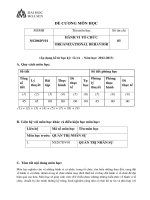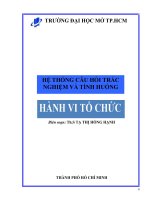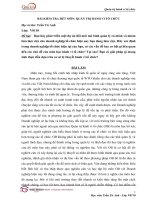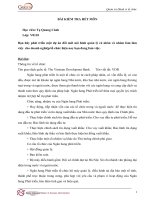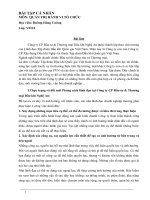Đề cương trắc nghiệm Hành Vi Tổ Chức (Organizational Behavior) CHƯƠNG 9
Bạn đang xem bản rút gọn của tài liệu. Xem và tải ngay bản đầy đủ của tài liệu tại đây (45.88 KB, 13 trang )
Chapter 9: Team Dynamics
9-1. Which of these are formal temporary teams that investigate a
particular problem and disband when a decision is made?
a. Quality circles
b. Self-directed work teams
c. Virtual teams
d. Task forces
e. Coalition groups
The question was not answered. The correct answer
is "d". (Coaching responses are only available for answered questions)
9-2. Which of these are usually temporary teams formed spontaneously
to develop products or solve complex problems.
a. Communities of practice
b. Management teams
c. Skunkworks
d. Self-directed work teams
e. Quality circles
The question was not answered. The correct answer
is "c". (Coaching responses are only available for answered questions)
9-3. Which of these are cross-functional groups that operate across
space, time, and organizational boundaries with members who
communicate mainly through electronic technologies?
a. Skunkworks
b. Quality circles
c. Virtual teams
d. Management teams
e. Self-directed work teams
The question was not answered. The correct answer
is "c". (Coaching responses are only available for answered questions)
9-4. Virtual teams are increasingly necessary because of:
a. Globalization
b. Social loafing
c. Technology
d. Production-based work
e. B and c only
The question was not answered. The correct answer
is "a". (Coaching responses are only available for answered questions)
9-5. Which of these is NOT an element in the organizational and team
environment that influence team effectiveness?
a. Reward systems
b. Physical space
c. Communication systems
d. Team cohesiveness
e. Organizational leadership
The question was not answered. The correct answer
is "d". (Coaching responses are only available for answered questions)
9-6. A homogeneous team is better than a heterogeneous team:
a. in situations where the team must reach the performing stage of
team development quickly.
b. on complex projects and tasks requiring innovative solutions
c. When the team needs to gain support from a variety of diverse groups
in the organization.
d. When the team requires a broad base of knowledge, experience, and
perspectives.
e. Under all of these conditions.
The question was not answered. The correct answer
is "a". (Coaching responses are only available for answered questions)
9-7. Which stage of the team development model is marked by
interpersonal conflict as members compete for leadership and other roles
in the team?
a. Adjourning
b. Forming
c. Storming
d. Performing
e. Norming
The question was not answered. The correct answer
is "c". (Coaching responses are only available for answered questions)
9-8. Forming, storming, and norming refer to:
a. The three elements of team effectiveness.
b. Three roles found in all organizational teams.
c. The three main causes of team cohesiveness.
d. The main stages of social loafing.
e. The first three stages of team development..
The question was not answered. The correct answer
is "e". (Coaching responses are only available for answered questions)
9-9. The informal rules and expectations that groups establish to regulate
the behaviour of their members is called
a. norms
b. roles
c. cohesiveness.
d. interdependence.
e. composition.
The question was not answered. The correct answer
is "a". (Coaching responses are only available for answered questions)
9-10. Initiator, evaluator, and harmonizer are:
a. Ways that people engage in social loafing.
b. Types of team roles.
c. Ways to weaken team cohesiveness.
d. The first three stages of team development.
e. Three of the main team building strategies.
The question was not answered. The correct answer
is "b". (Coaching responses are only available for answered questions)
9-11. The degree of attraction people feel toward the team and their
motivation to remain members is called:
a. Social loafing.
b. Team roles.
c. Task interdependence.
d. Team cohesiveness
e. Team composition
The question was not answered. The correct answer
is "d". (Coaching responses are only available for answered questions)
9-12. Which of these factors is NOT identified in the textbook as a cause
of team cohesiveness?
a. Member similarity.
b. Team size.
c. Team success.
d. Member interaction.
e. Forming coalitions
The question was not answered. The correct answer
is "e". (Coaching responses are only available for answered questions)
9-13. Team cohesiveness tends to be stronger by:
a. ensuring that the team has at least 25 members at all times.
b. making it relatively easy to become a team member.
c. creating or sensitizing the team to an external threat to its
existence or goal accomplishment.
d. ensuring that team members have independent tasks from other team
members.
e. Ensuring that both 'b' and 'd' exist.
The question was not answered. The correct answer
is "c". (Coaching responses are only available for answered questions)
9-14. Which of these teams become cohesive more easily?
a. Virtual
b. Homogeneous
c. Management
d. Large
e. Heterogeneous
The question was not answered. The correct answer
is "b". (Coaching responses are only available for answered questions)
9-15. The extent that cohesiveness results in higher team performance
depends on:
a. whether the team is small enough.
b. the extent to which team is heterogeneous.
c. the extent that team norms are consistent with organizational
goals.
d. the ease of entry into the group.
e. All of these.
The question was not answered. The correct answer
is "c". (Coaching responses are only available for answered questions)
9-16. Which of the following refers to the situation in which people
perform at a lower level when working in groups than when working
alone?
a. social loafing.
b. team development.
c. team building.
d. skunkworks.
e. team cohesiveness.
The question was not answered. The correct answer
is "a". (Coaching responses are only available for answered questions)
9-17. Dialogue is typically associated with which type of team building?
a. Goal setting
b. Role definition
c. Problem solving
d. Interpersonal process
e. Both 'a' and 'c'
The question was not answered. The correct answer
is "d". (Coaching responses are only available for answered questions)
TRUE or FALSE
9-1. All groups are teams, but not all teams are groups.
True / False
The question was not answered. The correct answer
is "False". (Coaching responses are only available for answered
questions)
9-2. Team-based organizations are typically formed around quality
circles..
True / False
The question was not answered. The correct answer
is "False". (Coaching responses are only available for answered
questions)
9-3. One factor that has made virtual teamwork feasible is the shift
towards knowledge-based rather than production-based work.
True / False
The question was not answered. The correct answer
is "True". (Coaching responses are only available for answered
questions)
9-4. Informal groups exist primarily to fulfil personal rather than
organizational needs.
True / False
The question was not answered. The correct answer
is "True". (Coaching responses are only available for answered
questions)
9-5. Recent evidence suggests that companies with the best team
dynamics are more likely to have individual-based rewards and merit
increases determined by the individual's contribution to the team.
True / False
The question was not answered. The correct answer
is "False". (Coaching responses are only available for answered
questions)
9-6. Two team processes are team norms and cohesiveness.
True / False
The question was not answered. The correct answer
is "True". (Coaching responses are only available for answered
questions)
9-7. Teams tend to work better when there are fewer layers of
management and they have more autonomy to accomplish their work.
True / False
The question was not answered. The correct answer
is "True". (Coaching responses are only available for answered
questions)
9-8. Teams are best suited for tasks with high interdependence among
team members.
True / False
The question was not answered. The correct answer
is "True". (Coaching responses are only available for answered
questions)
9-9. The optimal team size is usually more than 20 people.
True / False
The question was not answered. The correct answer
is "False". (Coaching responses are only available for answered
questions)
9-10. During the forming stage, team members begin to sort out the
specific features of different roles as well as to identify the members
responsible for each role.
True / False
The question was not answered. The correct answer
is "False". (Coaching responses are only available for answered
questions)
9-11. One way to improve team norms is to select people who bring
desirable norms to the group.
True / False
The question was not answered. The correct answer
is "True". (Coaching responses are only available for answered
questions)
9-12. Smaller teams tend to be more cohesive then larger teams.
True / False
The question was not answered. The correct answer
is "True". (Coaching responses are only available for answered
questions)
9-13. External threats and inter-team rivalries tend to reduce a team's
cohesiveness.
True / False
The question was not answered. The correct answer
is "False". (Coaching responses are only available for answered
questions)
9-14. Dialogue is an important activity in team building.
True / False
The question was not answered. The correct answer
is "True". (Coaching responses are only available for answered
questions)
